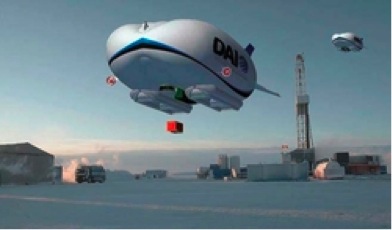Estimated reading time 18 minutes, 57 seconds.
 Canadian specialty aviation services firm Discovery Air, through its newest subsidiary Discovery Air Innovations, has signed on as the launch customer for Hybrid Air Vehicles Limited Commercial Heavy Lift program.
Canadian specialty aviation services firm Discovery Air, through its newest subsidiary Discovery Air Innovations, has signed on as the launch customer for Hybrid Air Vehicles Limited Commercial Heavy Lift program.
Discovery signed an agreement with the U.K. company for up to 45 lighter-than-air (LTA) airships, with the first delivery scheduled as early as 2014 (depending on the uncertainties of certification). With an estimated cost of $30 to $50 million per aircraft, the order final value could be in the order of $1.5 to $2 billion.
The news was announced at Cargo Airships for Northern Operations, a conference organized by NASA Ames Research Centre with Alaska State Transportation that took place in Anchorage in late August.
Some readers may have been following developments to build modern airships using LTA gases for lift with the application of modern technologies in materials, engines and controls. For the last 10 years various air heads have been predicting the resurrection of aircraft using buoyant lift as a new mode of transport, one that could open the north resources for economic development where there is no surface infrastructure. They promise transport at less than half the cost of current fixed wing services transport that may even compete with the total distributed costs of seasonal sea or winter road routes.
Hybrid Air Vehicles (HAV) has been developing hybrid buoyant aircraft for 10 years. The envelope is an air foil shape that generates lift aerodynamically as a flying wing. This lifts the payload while the helium buoyancy lifts the aircraft weight.
HAV made its first major sale of a large hybrid platform when Northrop Grumman won the U.S. Army LEMV (long endurance multi-intelligence vehicle) for surveillance over Afghanistan. This half billion dollar contract, awarded in June 2010, calls on HAV to provide three of its football field-sized hybrid platforms; the first could be test flying over Lakehurst by the time you read this. With the military kick-off of a full-size buoyant aircraft, believers felt it was only a matter of time before a heavy lift cargo version followed.
Some readers may not be familiar with Discovery although they likely know its subsidiaries’ names. Formed in 2004, its first acquisition was Hicks and Lawrence, followed in 2006 by Great Slave Helicopters and Air Tindi. In 2007, Top Aces joined Discovery and it opened DA Technical Services in 2010, with Discovery Air Innovations becoming its newest business unit in 2011. All together, Discovery operates a fleet of some 150 aircraft with 600 employees. It is a major Canadian aviation company that trades on the TSX as DA.A and DA.DB.
Discovery Air Innovations operates with a specific focus on the launch of disruptive technologies and new market penetration. Signing on for 45 airships that will spark a potential paradigm shift in how goods are moved through the air would certainly qualify as a disruptive technology.
DAI President Paul Bouchard described the opportunity: With a cargo capacity of 50 tonnes at speeds up to 100 knots, we believe this capability will enable economic development of remote, stranded resources with a low environmental impact. The ability to deliver cargo point-to-point without the need for a runway will mean the infrastructure costs of our clients are reduced substantially.
I caught up to Stephen (Fig) Newton, DAI Director of Business Development, at Vancouver Airport on his way home from Anchorage. I questioned Newton about the size of the Discovery order: wouldn’t five be more realistic? What is the potential for this type of craft? Newton referenced various market studies over the past 10 years that suggest a market capacity of anywhere from a hundred to 1,500; their best guess is 150 to 200 units will initially be needed worldwide. But he also cited his experience with unmanned air vehicle (UAV) development some years ago when predictions were that dozens would be required yet today there are some 8,000 in operation. That, he said, is what you call a paradigm shift.
Newton predicted an exciting future for the north. The LTA technology holds the promise of economic transport without resulting damage to sensitive terrain; features much lower emissions than current aircraft; and has the ability to overcome the new challenges of climate change. These airships could open up the north to economic development, allowing access to scarce resources. And the presence of these craft in the north strengthens Canada sovereignty claims.
Now, we just need to spend the next three years finding out if they can work in the challenging environment of Canada north.
LINKS:
http://www.da-innovations.com/
http://www.hybridairvehicles.com/








